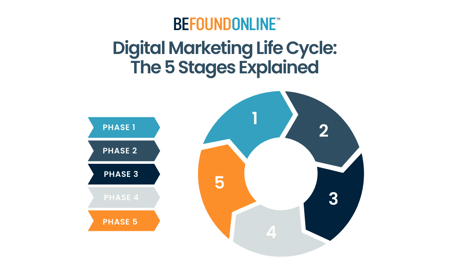Digital Marketing Life Cycle: The 5 Stages Explained - BFO
March 23, 2023
6 Minute Read

According to research, about 356 billion U.S. dollars were spent on digital advertising in 2020, which is expected to rise over the coming years. These figures highlight the importance of digital advertising for both small and established businesses.
With these increasing amounts of money being utilized in digital marketing campaigns, it is becoming more vital than ever for organizations to have solid strategies behind their digital marketing campaigns to ensure that they are using their resources effectively. Putting millions behind a campaign targeted at the wrong audience is a sure-fire way to find failure. The 5 Stages of the Digital Marketing Life Cycle is one practice for creating a strategy that takes a holistic approach to your business goals.
Why Is Digital Marketing Important?
Digital marketing refers to the process of targeting a particular group through campaigns that rely on technology. As our use of technology increases over time, so does the importance of digital marketing. Selling the best product online no longer guarantees that you will succeed or even be found by your target customer base. Success is now determined by the ability of a business to get in front of their target audience through a variety of digital channels – like search results, social media, and email to name a few – and to provide them with the information they need in order to convert (AKA make a purchase or secure services).
Simply put, digital marketing is vital for increasing customer loyalty, targeting the right audience, gaining brand credibility, accurately measuring results, and generating a consistent lead pipeline.
The 5 Stages of Digital Marketing
Knowing the importance of digital marketing is one thing; it’s another to understand how to use it to your advantage. Digital advertising is not plug-and-play; it requires piecing together different aspects of your business to see it grow and attain your financial goals. The 5 Phases of Digital Marketing have no set timeline for each phase, and they are meant to be viewed as a continuous working strategy, not a linear timeline, meaning that once you reach phase 5, it’s time to head back to square one.
Phase 1: Setting Up and Laying Down Your Digital Marketing Strategy
The first stage of the digital marketing lifecycle begins with a strategy. Before starting a digital marketing campaign, you must first develop and lay down a strategy that you think will work. To develop this initial strategy, begin by figuring out your business’s goals, assessing the challenges that you are likely to encounter, and determining what value you want to add to anyone that will stumble on your adverts. Some important questions you can ask yourself to help determine these items are:
- Who is your target audience?
- How are your products or services unique from the rest?
- What problems do you want to solve for your customers?
- Which is the best digital platform to create and publish your content?
- Do you have any strategies to measure the success or failure of your digital marketing campaign?
- What type of content do you plan to produce and publish?
The goal here is to figure out what channels your efforts should be spent in to achieve your goals by better understanding your audience and the different stages of their customer lifecycle. You may want to develop a working content marketing strategy based on this information that can help support the different channels your plan on interacting with. You also want to ensure that you have analytics set up on your website so that you can track and monitor data to help inform future decisions. If you already do, try to use this data to determine which channels have been most profitable to your business so far (organic, paid, social, email, etc.). At the end of this phase, you should have the foundation of a digital marketing strategy unique to your specific goals and target audience.
Phase 2: Implementation and Traction
The first stage is understandably challenging, but it sets you up for a smooth path to proceed for the second phase: implementation and traction.
Using the information you gathered in the first stage, begin to implement your digital marketing strategy. How fast or slow you go with your digital marketing campaign depends on what you want to achieve in the end and your budget.
The key here is to build a relationship with your target audience while collecting as much data as possible through analytics. Let this data begin to paint the picture of how your target audience is reacting to your brand through the different channels you have chosen to pursue. Focus on creating and maintaining healthy relationships with your target audience and customers. To achieve this, engage with your audience, especially personally, if you can. Ask them what they think about your services and how they think you should improve. Your goal in this phase is to gain traction with your intended customers, let them get familiar with your business and provide them with the answers they might be searching for around your product or service.
People like to buy from people. So make it clear that behind your website or business name, that’s what your audience will find.
Phase 3: Conversion and Expansion
Usually, the main aim of running a digital marketing campaign is to convert your potential customers (your target audience) into actual paying customers. After engaging your target audience for some time, you need to strike when the iron is still hot. This phase is your opportunity to offer an easy conversion point for your audience and push them into the next phase of their customer lifecycle.
Perhaps you wanted to increase your sales, improve your brand loyalty, or book more patients — this is the right time to convert and expand your customer base. Consider serving targeted ads or customized email offers to your audience to help move them along the conversion path. This is also a good opportunity to offer referral programs to any customers who have converted already to help expand your audience base.
While at it, pause and reflect on how your digital campaign has been so far. Regardless of how successful your run has been, critical analysis will show you some areas that need to be fine-tuned. Look at all the data at your disposal, analyze it keenly and make decisions based on your findings. Pay special attention to who has been converting and what the cost per conversion has been for different audience groups you may have identified.
Phase 4: Understanding Client Desires
At this stage, you probably know whether your digital marketing campaign has been successful or not. If it wasn’t, do not despair; look at where you might have gone wrong and try to make amends. If you were successful, do not let it get to your head or have you thinking that you have it all figured out.
As we mentioned earlier, your data can paint a big picture of what your customers desire. Pay attention to where they are dropping off in your conversion timeline, what channels are most successful, and any messaging that seems to particularly appeal to your target audience. If you put most of your budget towards paid ads, but email marketing is providing a better return, then that may be a signal that your audience prefers more personalized or relational communication. Similarly, you may find that much of your audience engages with your brand on social media, but your emails have a low open rate. In this scenario, putting more resources behind social campaigns may be more effective.
This is also a good time to reach out to your target audience directly and ask them what they like. Send out a survey to gauge levels of interest in new products or communication style. Ask for reviews to better understand how your digital marketing campaign is performing and what can be improved on.
Phase 5: Re-plan and Research
Now that you have the data, it is time to really make use of it. Find the gaps in your strategies, as well as the wins. In many ways, phase 5 mimics phase 1 of The Digital Marketing Lifecycle. This is your opportunity to adjust your strategy and better fine tune it. Make sure your initial target audience is really who you should be going after. Review the unique selling points of your products or services and see if they are still viable. See if your audience identified with any of your content more or less than others. Use all of the information that you have gathered to adjust and get back in the game.
Since digital marketing relies on technology, which is continuously evolving, this is also your time to look for the latest trends in your niche and evolve with them. Review competitors to see if they are offering value that you currently aren’t, but have the capacity to. Look for new and valuable platforms that may be making an impact that you haven’t been engaging with (did someone say TikTok?). See if your organic performance (search results) is up to par or if you could improve visibility in that area.
Do the research and adjust your digital marketing strategy accordingly. Then head back to phase 2 and get in the game again.
Enhance Your Digital Presence
We cannot evade the fact that customer buying habits have changed, but are you keeping up? Be Found Online is a digital marketing agency that is committed to keeping clients current, achieving their goals, and operating with transparency to make digital marketing efforts a little easier to understand.Whether you are looking for help with your Paid Media performance, Organic performance, or to better understand your business’s data and analytics BFO, we can help you build an adaptive digital marketing strategy that enables you to achieve your goals. Contact us today, and let’s talk about digital marketing transformation.

The BFO Team
Here at BFO, we're always striving to bring you the latest and greatest in digital marketing insights and education. We're not ones to brag, but we've been lucky enough to be featured in all sorts of fancy publications and media outlets, strutting our stuff and showing off our industry expertise.
CATEGORIES
SUBSCRIBE TO OUR BLOG
Stay up to date with the latest industry best practices in digital marketing!























.png?width=339&height=179&name=Webinar%20Banner%20(1).png)



.png?width=339&height=179&name=July%20Webinar%20(Newsletter).png)

.png?width=339&height=179&name=Webinar%20Banner-April-02%20(1).png)
%20(4).png?width=339&height=179&name=Webinar%20Banner-May-02%20(1)%20(4).png)




.png?width=339&height=179&name=March%202023%20Webinar%20Ad%20(autoresponder).png)

















































